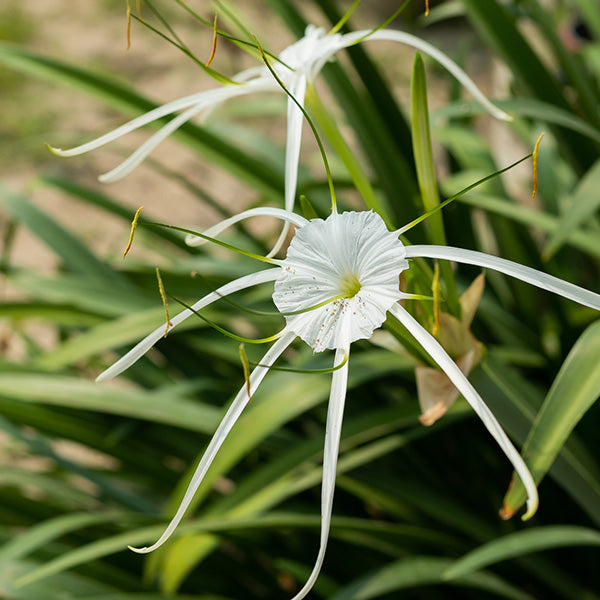



Spider Lily White Bulbs
Plant Height : Grows Up To 24 to 35 inches
Flower Shape: Long tubular petals curved outwards resembling spider legs
Colour : Six slender pristine white, elongated petals that curve gracefully outward
Growing Tip : Plant bulbs with their necks slightly exposed above the soil surface
- SOWING
TIMEFebruary to April
- Sowing
DistancePlant to plant - 6 to 12 inches
- Fruit
WeightN/A
- Fruit
ShapeN/A
- Days to
maturity60 to 90 days
- Details
- How to sow
- Reviews
Introducing the spider lily white bulbs that are perfect for adding elegance and beauty to your garden. Also known as Hymenocallis, this exquisite bulb features long, slender stems adorned with delicate pure white flowers. With their captivating scent and elegant appearance, white spider lily bulbs subtly enhance any outdoor space. Plant in well-drained soil, preferably in a semi-shade, and watch it grow in both garden beds and containers. Blooming in late summer, these hardy bulbs provide a nice contrast to the lush green foliage. Whether you're an experienced gardener or a novice, these white spider lily bulbs are a must-have for creating a picture-perfect garden paradise. BUY NOW and add a touch of magic to your outdoor oasis.
Planting instructions
Spider Lily White bulbs should be planted at a depth of about 2 to 3 inches (5 to 8 centimeters) in the soil. Ensure that the pointed ends of the bulbs face upwards while planting. This depth provides the bulbs with adequate protection and stability, allowing them to establish their roots and thrive in the garden. Planting at the correct depth ensures proper nutrient absorption and moisture retention for healthy growth and beautiful blooms.
When planting Spider Lily White bulbs, it is essential to space them adequately to allow each plant to grow and flourish. Maintain a spacing of approximately 12 to 18 inches (30 to 45 centimeters) between each bulb. This spacing allows ample room for the plants to spread their foliage and showcase their elegant white flowers. Sufficient spacing also ensures proper air circulation, preventing overcrowding and reducing the risk of diseases. By giving each bulb its own space, you enable the plants to reach their full potential and create a stunning display in your garden.
Growing Requirements
Pests
These bulbs can be susceptible to a few common issues that gardeners should be aware of. One potential pest is the spider mite, which can cause yellowing leaves and webbing. To combat this, regularly inspect the leaves and spray a gentle insecticidal soap solution to deter these tiny pests. Another concern is fungal diseases like bulb rot, which can occur if the bulbs are planted in poorly drained soil. To prevent this, ensure proper soil drainage and avoid overwatering. By staying vigilant and taking preventive measures, you can enjoy the beauty of spider lily white bulbs without the interference of these pests and diseases.
soil
These beautiful flowers thrive in well-draining soil that is rich in organic matter. The ideal soil for spider lilies is a loamy or sandy loam soil. To create the perfect soil mix for spider lilies, you can start by incorporating organic matter such as compost or well-rotted manure. This will improve the soil's fertility, structure, and moisture-holding capacity. It's important to ensure that the soil pH is slightly acidic to neutral, preferably around 6.0 to 7.0. Remember, spider lilies dislike soggy conditions, so avoid heavy clay soils that can lead to waterlogging and root rot.
spot
Spider Lily White Bulbs thrive in bright, indirect sunlight. Aim for a location that receives at least 4-6 hours of sunlight daily. Avoid direct, intense sunlight as it can scorch the delicate petals. An ideal spot would be a garden bed or patio with partial shade or filtered sunlight throughout the day.
temperature
For the best results, aim for a soil temperature ranging between 60 to 70°F(15 to 21°C). To ensure that the soil temperature remains within the ideal range, consider planting spider lily white bulbs in late spring or early summer when the soil has had a chance to warm up. This timing provides the bulbs with the best conditions for successful growth.
watering
During the growing season, water your spider lilies regularly to keep the soil consistently moist. Aim for a watering schedule of once every 7-10 days, depending on your climate and rainfall patterns.
how to harvest
The blooming duration of Spider Lily White bulbs typically extends from late spring to early summer, treating you to a profusion of delicate flowers.
As per upkeep, remove any spent flowers to encourage continuous blooming. These low-maintenance bulbs are perfect for both novice and experienced gardeners, adding a touch of grace and charm to borders, containers, or even indoor arrangements.

The productiveness of any seed we sell is subject to your local climatic conditions*, the sowing method you adopt, and your commitment to the planting process. We give no warranty, expressed or implied, and are in no way responsible for the produce.
Please note that all our seasonal recommendations/ sowing information is as per the local climatic conditions. *For more information on the optimum conditions required for growing seeds in your region, please contact us at, hello@allthatgrows.in or Whatsapp us at, +91 8544865077
Questions & Answers
Have a Question?
Be the first to ask a question about this.




Spider Lily White Bulbs
Plant Height : Grows Up To 24 to 35 inches
Flower Shape: Long tubular petals curved outwards resembling spider legs
Colour : Six slender pristine white, elongated petals that curve gracefully outward
Growing Tip : Plant bulbs with their necks slightly exposed above the soil surface
Introducing the spider lily white bulbs that are perfect for adding elegance and beauty to your garden. Also known as Hymenocallis, this exquisite bulb features long, slender stems adorned with delicate pure white flowers. With their captivating scent and elegant appearance, white spider lily bulbs subtly enhance any outdoor space. Plant in well-drained soil, preferably in a semi-shade, and watch it grow in both garden beds and containers. Blooming in late summer, these hardy bulbs provide a nice contrast to the lush green foliage. Whether you're an experienced gardener or a novice, these white spider lily bulbs are a must-have for creating a picture-perfect garden paradise. BUY NOW and add a touch of magic to your outdoor oasis.
Plant Height : Grows Up To 24 to 35 inches
Flower Shape: Long tubular petals curved outwards resembling spider legs
Colour : Six slender pristine white, elongated petals that curve gracefully outward
Growing Tip : Plant bulbs with their necks slightly exposed above the soil surface
- SOWING
TIMEFebruary to April
- Sowing
DistancePlant to plant - 6 to 12 inches
- Fruit
WeightN/A
- Fruit
ShapeN/A
- Days to
maturity60 to 90 days
Planting instructions
Spider Lily White bulbs should be planted at a depth of about 2 to 3 inches (5 to 8 centimeters) in the soil. Ensure that the pointed ends of the bulbs face upwards while planting. This depth provides the bulbs with adequate protection and stability, allowing them to establish their roots and thrive in the garden. Planting at the correct depth ensures proper nutrient absorption and moisture retention for healthy growth and beautiful blooms.
When planting Spider Lily White bulbs, it is essential to space them adequately to allow each plant to grow and flourish. Maintain a spacing of approximately 12 to 18 inches (30 to 45 centimeters) between each bulb. This spacing allows ample room for the plants to spread their foliage and showcase their elegant white flowers. Sufficient spacing also ensures proper air circulation, preventing overcrowding and reducing the risk of diseases. By giving each bulb its own space, you enable the plants to reach their full potential and create a stunning display in your garden.
Growing Requirements
Pests
These bulbs can be susceptible to a few common issues that gardeners should be aware of. One potential pest is the spider mite, which can cause yellowing leaves and webbing. To combat this, regularly inspect the leaves and spray a gentle insecticidal soap solution to deter these tiny pests. Another concern is fungal diseases like bulb rot, which can occur if the bulbs are planted in poorly drained soil. To prevent this, ensure proper soil drainage and avoid overwatering. By staying vigilant and taking preventive measures, you can enjoy the beauty of spider lily white bulbs without the interference of these pests and diseases.
soil
These beautiful flowers thrive in well-draining soil that is rich in organic matter. The ideal soil for spider lilies is a loamy or sandy loam soil. To create the perfect soil mix for spider lilies, you can start by incorporating organic matter such as compost or well-rotted manure. This will improve the soil's fertility, structure, and moisture-holding capacity. It's important to ensure that the soil pH is slightly acidic to neutral, preferably around 6.0 to 7.0. Remember, spider lilies dislike soggy conditions, so avoid heavy clay soils that can lead to waterlogging and root rot.
spot
Spider Lily White Bulbs thrive in bright, indirect sunlight. Aim for a location that receives at least 4-6 hours of sunlight daily. Avoid direct, intense sunlight as it can scorch the delicate petals. An ideal spot would be a garden bed or patio with partial shade or filtered sunlight throughout the day.
temperature
For the best results, aim for a soil temperature ranging between 60 to 70°F(15 to 21°C). To ensure that the soil temperature remains within the ideal range, consider planting spider lily white bulbs in late spring or early summer when the soil has had a chance to warm up. This timing provides the bulbs with the best conditions for successful growth.
watering
During the growing season, water your spider lilies regularly to keep the soil consistently moist. Aim for a watering schedule of once every 7-10 days, depending on your climate and rainfall patterns.
how to harvest
The blooming duration of Spider Lily White bulbs typically extends from late spring to early summer, treating you to a profusion of delicate flowers.
As per upkeep, remove any spent flowers to encourage continuous blooming. These low-maintenance bulbs are perfect for both novice and experienced gardeners, adding a touch of grace and charm to borders, containers, or even indoor arrangements.



 Sign In
Sign In








